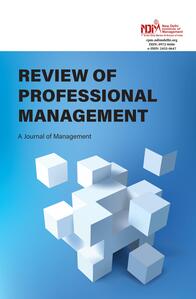
1Department of Marketing & Strategy, IBS Hyderabad, IFHE University, Hyderabad, India
Creative Commons Non Commercial CC BY-NC: This article is distributed under the terms of the Creative Commons Attribution-NonCommercial 4.0 License (http://www.creativecommons.org/licenses/by-nc/4.0/) which permits non-Commercial use, reproduction and distribution of the work without further permission provided the original work is attributed.
The value co-destruction (VCD) as a concept has been overshadowed by the focus of services research on value co-creation. The usefulness of service and value has been mentioned multiple times in the literature on service-dominant logic. The logical idea that, if value can be jointly created, it can also be jointly destroyed through similar interactional processes among the service systems has simply been ignored by the services study. In order to better grasp the notion of VCD and to pinpoint prospective areas for related future research, this article attempts to bring it to light. This study aims to do an in-depth literature review to identify the major aspects related to VCD that have been studied so far and thereby identify the gaps in the VCD literature to highlight the scope for related future research.
Value co-destruction, co-destruction of value, interactive value formation, S-D logic, resource integration, service system interactions, negative value outcomes
Introduction
According to Philip Kotler (1972), marketing is an organised method of creating and providing value to others in order to elicit the desired reaction. The fundamental element of marketing is transaction, which is nothing more than a trade of values between the parties. In addition to goods, services and money, other resources, such as time, energy and even feelings, can also be exchanged as things of value. Value has been defined by Vargo et al. (2008, p. 149), as ‘an improvement in system well-being’, where well-being refers to ‘system adaptiveness or ability to fit in its environment’. The study of Diener et al. (1999, p. 276) also explains well-being as a set of incidents that comprise the emotional responses of the people combined with their judgements of life satisfaction, thereby highlighting the need to ensure that there is an improvement in well-being to guarantee value to the customer. Value has also been regarded as a trade-off between resources that are sacrificed (costs) so as to receive certain returns (benefits) (Zeithaml et al., 1988).
Value co-creation (VCC), according to Vargo and Lusch (2004) and Vargo (2008), is said to happen when the customers integrate their resources with that of the organisation to derive value from the value propositions offered by the service provider. The focus of VCC is on the integration of resources that happens during the interaction between the service systems. Vargo et al. (2008, p. 145) defined service systems as ‘configurations of resources (including people, information, and technology) connected to other systems by value propositions’. These service systems are nothing but the actors that are involved in the interaction process and include firms, customers, suppliers, employees and all the other partners in a firm’s network. These service systems or actors tend to integrate their resources with that of the other systems in the interaction process so as to create value for themselves and also for the other systems involved (Lusch & Vargo, 2006; Spohrer et al., 2007; Vargo et al., 2008). This makes the customers or any other service system for that matter assume the role of a resource integrator, thereby facilitating value rather than being a mere passive receiver of value.
From the foregoing discussion, it is evident that the implicit premise of S-D logic is that interactions between service systems/actors have an innate tendency to lead to VCC. But it need not always be the case. The service literature has seen an overwhelming focus of research on VCC, which has simply overlooked the possibility of an equally important concept of value co-destruction (VCD). This study seeks to raise awareness of VCD in an effort to better comprehend the idea and to pinpoint areas that could be studied further in the future. This article seeks to bring attention to VCD, in an effort to better comprehend the concept of VCD by reviewing the work done so far on the concept and to identify potential areas for related future research.
Value Co-destruction
The term ‘value co-destruction’ was first coined by Plé and Cáceres (2010, p. 431), who defined it as ‘an interactional process between service systems that results in a decline in at least one of the systems’ well-being’. The study by Echeverri and Skålén (2011) has highlighted that just like VCC, VCD should also be considered as an integral part of the interaction between the providers and customers. Their study states, ‘While co-creation refers to the process whereby providers and customers collaboratively create value, co-destruction refers to the collaborative destruction, or diminishment, of value by providers and customers’. When value can be considered as a trade-off between costs and benefits (Zeithaml et al., 1988), VCD is said to occur when the costs of engaging and integrating resources in the interaction process exceed the benefits achieved in return. As Prior and Marcos-Cuevas (2016) pointed out, VCD can be considered as the net deficit between costs and benefits.
Resource misuse or misintegration has been considered as the major cause of VCD (Laud et al., 2019; Plé & Cáceres 2010). The resources that are integrated by the service systems to create value for the other systems might also be utilised in a manner that has detrimental effects on the other systems, thereby resulting in VCD for at least one of the systems involved. Every system entering the interaction process has certain expectations about its roles and responsibilities and that of the other systems in terms of resource integration, in order to create value. According to Plé and Cáceres (2010), resources are considered to be misused when they are utilised in a manner that is considered unexpected or inappropriate by other systems involved in the interaction process.
Literature Review
The services literature presents evidence of a few studies that have focused on co-destruction of value and several aspects related to the same. The authors have done a review of such literature so as to gain a good understanding of what are the different aspects (about VCD) that have already been studied. This helps in two ways: first, it helps us in understanding the concept of VCD better, second, it helps us in identifying the areas that are yet to be researched. The findings, or rather the observations, of the literature review are given in Table 1.
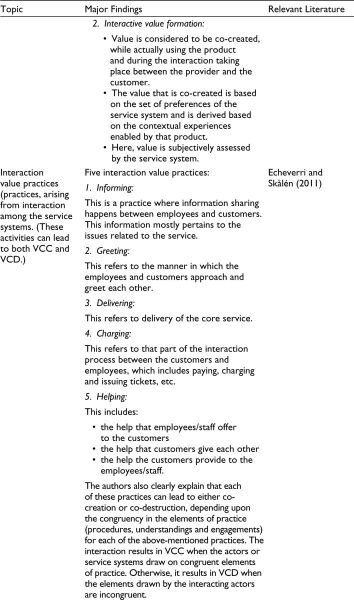
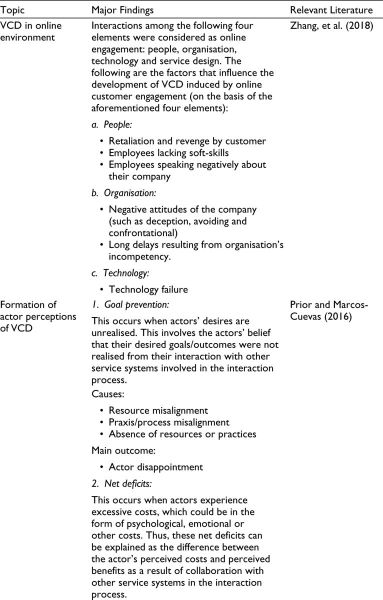
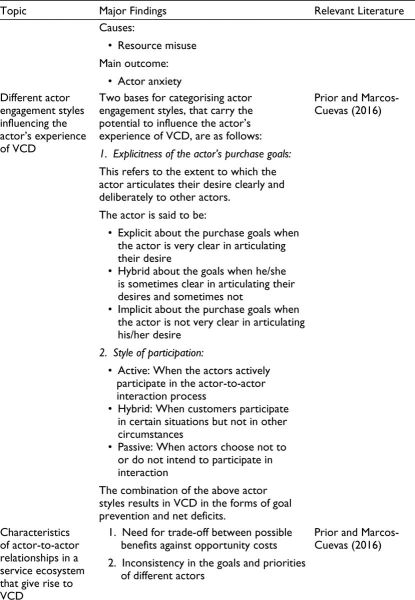


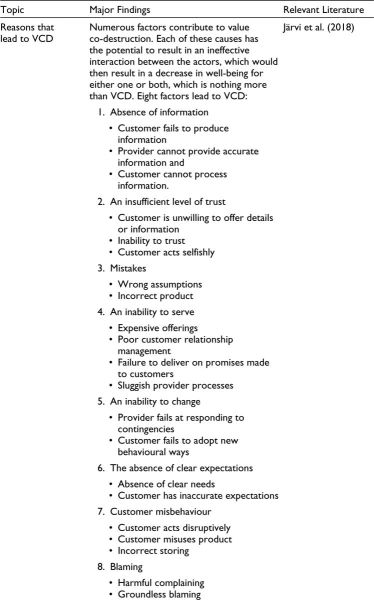

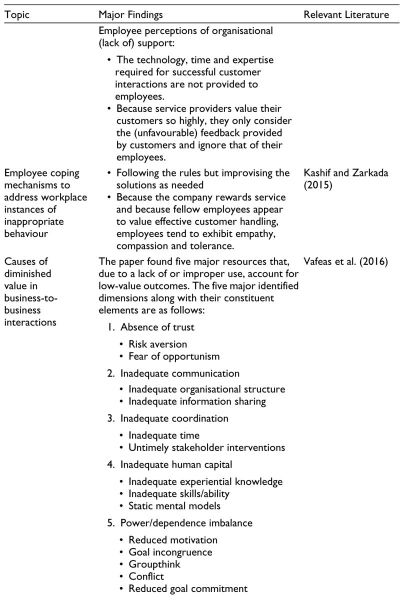
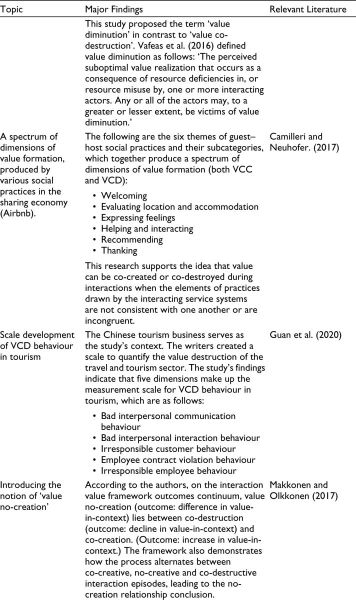
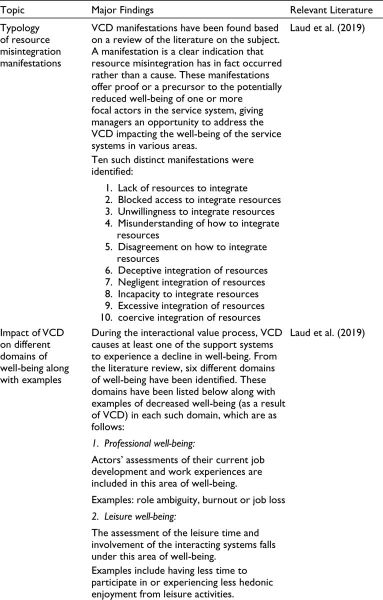
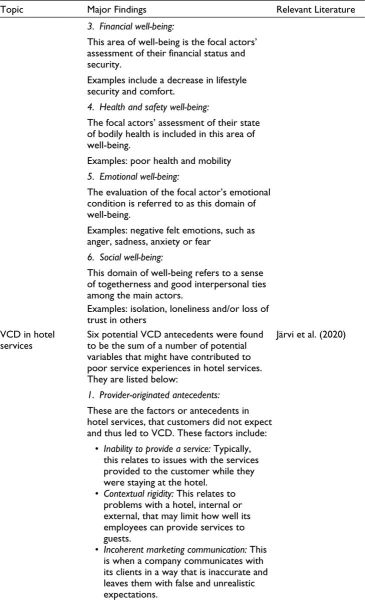
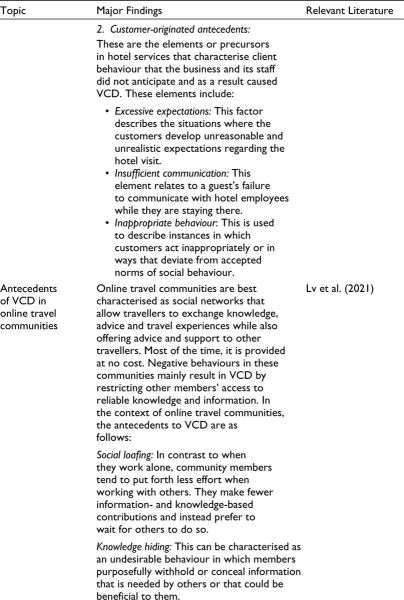
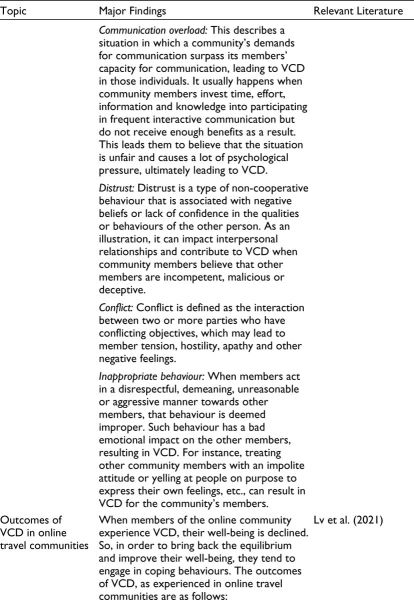

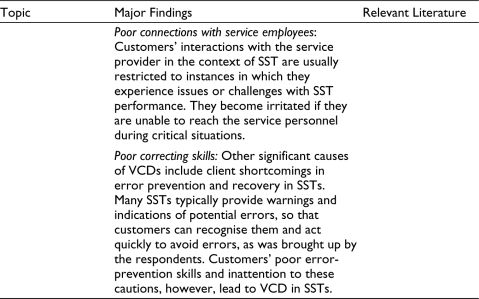
Potential Areas of Future Research
From the literature review (discussed above), it can be observed that research on VCD has been gaining momentum over the years, and yet there is so much that still needs to be researched to learn more about VCD. It would, hence, be really helpful to look for the potential areas of future research, primarily from the perspective of ‘Transformative Service Research’ (TSR). TSR can be defined as any research endeavour that, at its core, examines the connection between service and well-being and places a focus on both indicators of growing and decreasing well-being. TSR primarily exemplifies research that is concerned with bringing about ‘uplifting changes’ that are meant to enhance the quality of life for people (both consumers and workers), families, communities, society and the ecosystem as a whole (Anderson et al., 2013). According to this TSR methodology, the emphasis on well-being issues in services also arises when at least one of the service systems involved in the interaction process has been harmed—either unintentionally, unknowingly or occasionally even intentionally—by services. And VCD by definition talks about well-being diminished or decreased and, hence, studying VCD from the TSR perspective will hold interesting implications for not just managers and researchers but also the society at large. Because much of the literature was focused on the co-creation of value, researchers have not focused much on the co-destruction of value and this article acts as a point of reference for the researchers in future by giving a detailed review of the work that has already been done in the area of VCD and also by listing out the potential areas (related to VCD) for future research.
Given the increasing level of interactive value formation in recent years, I believe that just as the co-creation of value, the co-destruction of value is also inevitable. So, from the TSR perspective, the following are the potential areas of future research (related to VCD):
Other areas for potential future research:
Potential drivers of stress experienced by service employees and customers (as a result of VCD).
The co-creation and co-destruction of value are like the two sides of the same coin. If VCC is possible, then VCD is also equally possible. So, studying VCD might offer interesting and fascinating avenues for research, specifically in services marketing, while also helping us to get a wholesome understanding of the interaction value process.
Declaration of Conflicting Interests
The authors declared no potential conflicts of interest with respect to the research, authorship and/or publication of this article.
Funding
The authors received no financial support for the research, authorship and/or publication of this article.
Anderson, L., & Ostrom, A. L. (2015). Transformative service research: Advancing our knowledge about service and well-being. Journal of Service Research, 18(3), 243–249.
Anderson, L., Ostrom, A. L., Corus, C., Fisk, R. P., Gallan, A. S., Giraldo, M., Mende, M., Mulder, M., Rayburn, S. W., Rosenbaum, M. S., Shirahada, K., & Williams, J. D. (2013). Transformative service research: An agenda for the future. Journal of Business Research, 66(8), 1203–1210.
Camilleri, J., & Neuhofer, B. (2017). Value co-creation and co-destruction in the Airbnb sharing economy. International Journal of Contemporary Hospitality Management, 29(9), 2322–2340.
Diener, E., Suh, E. M., Lucas, R. E., & Smith, H. L. (1999). Subjective well-being: Three decades of progress. Psychological Bulletin, 125(2), 276.
Echeverri, P., & Skålén, P. (2011). Co-creation and co-destruction: A practice-theory based study of interactive value formation. Marketing Theory, 11(3), 351–373.
Galdolage, B. S. (2021). Barriers for entering the digital world: Exploring customer value co-destruction in self-service technologies. FIIB Business Review, 10(3), 276–289.
Guan, X., Gong, J., Xie, L., & Huan, T. C. (2020). Scale development of value co-destruction behavior in tourism. Tourism Management Perspectives, 36, 100757.
Järvi, H., Kähkönen, A. K., & Torvinen, H. (2018). When value co-creation fails: Reasons that lead to value co-destruction. Scandinavian Journal of Management, 34(1), 63–77.
Järvi, H., Keränen, J., Ritala, P., & Vilko, J. (2020). Value co-destruction in hotel services: Exploring the misalignment of cognitive scripts among customers and providers. Tourism Management, 77, 104030.
Kashif, M., & Zarkada, A. (2015). Value co-destruction between customers and frontline employees: A social system perspective. International Journal of Bank Marketing, 33(6), 672–691.
Kotler, P. (1972). A generic concept of marketing. Journal of Marketing, 36(2), 46–54.
Laud, G., Bove, L., Ranaweera, C., Leo, W. W. C., Sweeney, J., & Smith, S. (2019). Value co-destruction: A typology of resource misintegration manifestations. Journal of Services Marketing, 33(7), 866–889.
Lusch, R. F., & Vargo, S. L. (2006). Service-dominant logic: Reactions, reflections and refinements. Marketing Theory, 6(3), 281–288.
Lv, X., Zhang, R., & Li, Q. (2021). Value co-destruction: The influence of failed interactions on members’ behaviors in online travel communities. Computers in Human Behavior, 122, 106829.
Makkonen, H., & Olkkonen, R. (2017). Interactive value formation in interorganizational relationships: Dynamic interchange between value co-creation, no-creation, and co-destruction. Marketing Theory, 17(4), 517–535.
Plé, L., & Cáceres, R. C. (2010). Not always co-creation: Introducing interactional co-destruction of value in service-dominant logic. Journal of Services Marketing, 24(6), 430–437.
Plé, L. (2017). Why do we need research on value co-destruction? Journal of Creating Value, 3(2), 162–169.
Prior, D. D., & Marcos-Cuevas, J. (2016). Value co-destruction in interfirm relationships: The impact of actor engagement styles. Marketing Theory, 16(4), 533–552.
Quach, S., & Thaichon, P. (2017). From connoisseur luxury to mass luxury: Value co-creation and co-destruction in the online environment. Journal of Business Research, 81, 163–172.
Spohrer, J., & Maglio, P. P. (2008). The emergence of service science: Toward systematic service innovations to accelerate co-creation of value. Production and Operations Management, 17(3), 238–246.
Vafeas, M., Hughes, T., & Hilton, T. (2016). Antecedents to value diminution: A dyadic perspective. Marketing Theory, 16(4), 469–491.
Vargo, S. L. (2008). Customer integration and value creation: Paradigmatic traps and perspectives. Journal of Service Research, 11(2), 211–215.
Vargo S. L., & Lusch, R. F. (2004). Evolving to a new dominant logic for marketing. Journal of Marketing, 68(1), 1–17.
Vargo, S. L., Maglio, P. P., & Akaka, M. A. (2008). On value and value co-creation: A service systems and service logic perspective. European Management Journal, 26(3), 145–152.
Zeithaml, V. A., Berry, L. L., & Parasuraman, A. (1988). Communication and control processes in the delivery of service quality. Journal of Marketing, 52(2), 35–48.
Zhang, T., Lu, C., Torres, E., & Chen, P. J. (2018). Engaging customers in value co-creation or co-destruction online. Journal of Services Marketing, 32(1), 57–69.